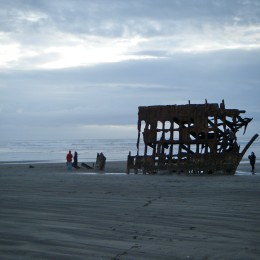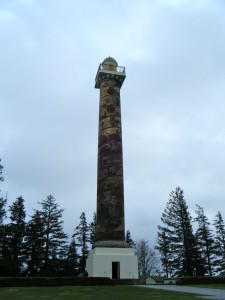
We visited the former fish cannery town of Astoria, in search of clues as to how the town came into being, and what happens to maritime commerce when the mighty Columbia River meets up with the even mightier Pacific.
The boys, their two friends, and we three adults have been here many times. We’ve watched as huge container ships made their way ever so slowly in the direction of Kalama and Portland/Vancouver. The passing ships seem to dwarf the buildings on the waterfront.
We’ve always pointed out to the kids that when they buy an item in Portland such as a toy, there’s a strong likelihood that that very toy made its way to the pacific Northwest on such a vessel, and quite possibly navigated the Columbia if it didn’t head for Puget Sound or the San Francisco Bay.
So if the kids wonder about the salmon feeling intimidated by this shipping going on, or the pollutants from such vessels entering the estuary, they need only to consider that their own material demands, and the consequent supply in the Portland area (and everywhere else), contribute to the situation.
But what we talked about this weekend was the fact that Astoria has been a huge commercial focal point ever since Europeans and white Americans took a shine to the place. Animal pelts, then commercial fishing, made big money for some and provided work for a great many others.
We reflected on the area’s history and how, up until outsourcing came along, people could come here and find work. One very dangerous job involved navigating boats of all sizes from the Pacific to the Columbia or vice versa. At the Columbia River Maritime Museum we viewed an excellent film and physical exhibits that highlighted the skills required to guide vessels past the Columbia Bar.
We learned about the heyday of fish canning in Astoria, and about the many immigrants and Northwesterners whose histories were shaped by the world’s commercial interest in Pacific canned fish products.
The town today is quiet. It needs more tourism and something for visitors to do other than shake their heads about how capitalism once picked the place up then let it come crashing down when other, cheaper areas were found that could yield a better bottom line for some rich man.
We were impressed by the inherent dangers of the sea, especially of that point where the ocean fights against the currents coming out of the mouth of the Columbia River.
We drove up to the beautifully rendered Astoria Column, with sweeping views of the Columbia estuary and Cape Disappointment near Ilwaco, Washington.
We also drove past the original house used in the 80s comedy The Goonies.
Then we headed over to the beach south of Hammond, Oregon to view the steel skeleton of a large shipwreck. An archaeological approach raised the question: How can we determine which vessel this wreck is?
The answer? Measure the wreck’s length and width from the tip of the bow to the very last ribs in what would have been the stern, and estimate the size. Then enter the location and size of the vessel in a search, to cross check for any historical information of a lost ship that size. The area is home to many, many sunken vessels; the ship’s name is of course no longer proudly on display due to damage and the elements. But it’s the wreck of the Peter Iredale, which occurred in 1906.




9. February 2011 at 3:13 pm
The shipwreck you saw was the Peter Iredale.
You can find information here:
http://www.ohs.org/education/oregonhistory/historical_records/dspDocument.cfm?doc_ID=46BA6E65-E25C-D9AA-D7FC7372D31F88D6
13. February 2011 at 6:26 am
Hello,
My name is Nicole Willson and I am a Community Specialist at RVParking.com, an RV park review website for RVers from all walks of life.
I really enjoyed reading your blog and I was wondering if you’d be interested in writing a guest blog post for us about homeschooling from the road as part of our RVing with kids series.
Please let me know if you’d be interested.
Thanks,
Nicole
13. February 2011 at 9:33 pm
Dear Nicole,
Thank you for asking me to guest blog at your site. We actually are not RV’ers, though we have tagged along with camping friends who own trailers and such. We’ve basically lived out of our station wagon and tent camped, and in the winter in the High Sierras, we rented a cabin. But someday if I ever do get us a real RV, I’d love to guest blog for you about how it functions as a homeschool on wheels. I must say I’ve had a hankering to get us a small RV.
15. March 2011 at 8:23 pm
The Goonies?? I must have missed out on that one – good thing I am keeping up-to-date with your blog!